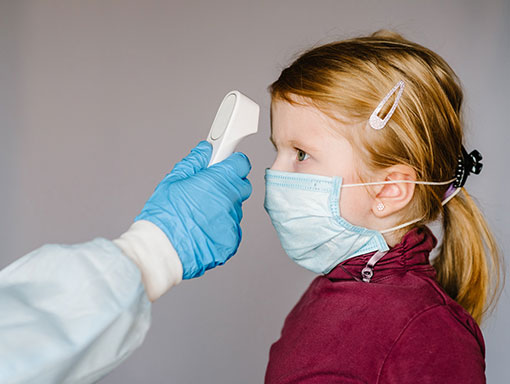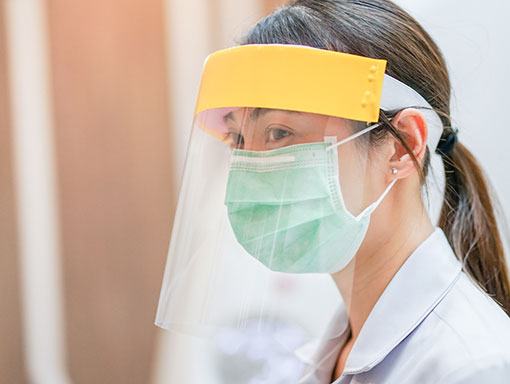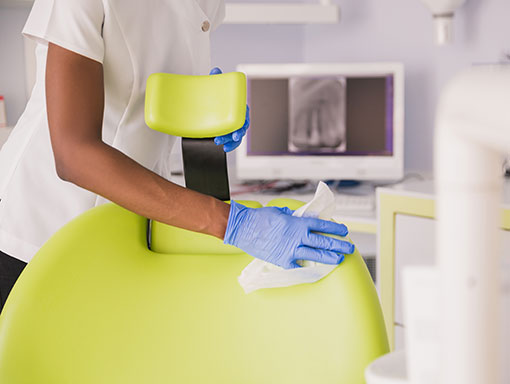
Schedule Appointment
Using our online form.
New Patients
Information for your first visit.
(815) 478-7788
Call our friendly staff today!
175 South State Street
Manhattan, IL 60442
Training and Educating Our Team
One of the most important things we are doing during this time is to train and educate our staff.
- Our team has had refresher training in proper handwashing techniques. This may seem basic; however, it is the most important thing we can do to prevent spread of the virus yet research shows that it is often poorly complied with and usually not done well. Consequently, we have spent a lot of time ensuring that our team does it well and often, especially before and after every patient encounter.
- They have practiced the appropriate use of personal protective equipment (PPE) prior to caring for a patient to prevent contamination.
- We encourage staff that are not feeling well to proactively stay home.
- We have everyone in the office take their temperature at the beginning of every day and we will immediately send home anyone with an elevated temperature (100 F and above).
- Limit the numbers of staff providing their care to facilitate social distancing within the office and among team members.
- We have created a specific checklist of recommendations for our team to follow so that they arrive to work healthy and go home to their families without worry. (see Checklist of Recommendations for Our Team)
Recommendations for Our Team
Before coming to work
- Take temperature (do not go in to work if you or any other family member are experiencing symptoms; cough, sore throat, fever…etc.). We will be repeating the temperature check at the office.
- Tie hair up, keep nails short
- Avoid extra accessories
- Place phone in a Ziplock bag that you will discard at the end of the day
- If bringing a lunch, place in disposable wrapping
- Activate ApplePay so there is no need for cash or credit card
- They have practiced the appropriate use of personal protective equipment (PPE) prior to caring for a patient to prevent contamination.
At work
- Use PPE as appropriate
- Leave all clutter (pens, phones, etc.) outside of patient op rooms
- We discourage workers from using other workers’ phones, desks, offices, and other work tools and equipment when possible.
- Clean phone handset after use
- Discourage cell phone use at work
After work
- Wash hands and arms with soap
- Remove scrubs and place in a washable bag (pillowcase)
- Wash hands and put clean clothes on
- Sanitize phone, glasses, etc
- Wash hands again
At home
- Do not touch anything
- Remove shoes and clothes
- Wash clothes/scrubs in the washing machine with detergent and hot water
- Shower immediately with soap and water before touching anything (including loved ones)
Patient Interviews and Social Distancing
Before patient arrival every effort is made to
- Filter patients using established and recommended screening checklists and scripts
- Prepare scripts and questions to recognize potential carriers
- Reschedule patients who show any signs of a cough or fever or who describe having any concerning warning signs
- Instruct patients to call ahead and reschedule their appointment if they develop symptoms of a respiratory infection (e.g., cough, sore throat or fever) on the day they are scheduled to be seen. We will not be charging cancelation fees during this time.
To promote social distancing
- Prioritize high-risk patients (immune-compromised, over 60 y.o. etc.) with early morning appointments so less contact with other people
- When booking patients, we are spreading out the schedule so there are less people in the waiting room
- If a patient is being accompanied, their escort should wait in the car to limit the number of people in the waiting room and promote social distancing
- Utilizing a “virtual” waiting room: patients can opt to wait in their car or outside the office where they can be contacted by mobile phone when it is their turn to be treated.
Safety measures taken upon arrival
- Limit points of entry to the clinic.
- Disinfection of door handles after every patient enters
- Tissues are made accessible immediately upon entry and instructions are provided on how to use tissues to cover nose and mouth when coughing or sneezing, to dispose of tissues and contaminated items in waste receptacles.
- Provide supplies such as alcohol-based hand rub (ABHR) with 70-95% alcohol, tissues, and no-touch receptacles for disposal, at the entrance, in waiting rooms, and at front desk.
ALL these measures can help to prevent transmission to others.
Measures Upon Arrival
Patients are
- Immediately escorted to a hand sanitizing station
- Temperature check prior to being escorted into exam room.
- Escorted into an examination room as quickly as possible.
- Asked to rinse with 1% hydrogen peroxide before each appointment
- Asked about the presence of symptoms of a respiratory infection and history of travel or contact with possible COVID-19 patients.
- Assessed for respiratory symptoms and fever (with a non-contact digital infrared forehead thermometer) and they will be asked to sign a health declaration form.
- If fever temperature of 100 degrees F or higher or respiratory symptoms are present, they will be advised to seek medical treatment and their visit will be rescheduled.
- As testing for the virus becomes more available, we will be incorporating this added benefit to screen patients.
Measures Taken Upon Patient Entry to the Clinic
- If an examination room is not readily available, ensure social distancing in the waiting room by placing seating a minimum of 6 feet apart.
- Remove all clutter and anything that is not easily disinfected from the waiting room (magazines, area rugs, pillows, toys, etc)
- Cover all furniture which cannot be disinfected with disposable covers (including chairs and couches) which will be replaced after each patient
- Frequent wipe down of waiting rooms, bathrooms, door handles, tables, light switches, computers…etc.
Reception Room and Front Desk Safety Measures
- Install physical barriers or partitions (e.g., glass or plastic windows) if possible, at reception areas to limit close contact between reception and potentially infectious patients.
- Place air-handling systems (with appropriate filtration, exchange rate, etc.)

Protocols of the Clinical Team
We adhere to usual standard and transmission-based precautions in operatory but with greater attention to detail and ensure that procedures are followed consistently and correctly.
Furthermore, we will employ an additional team member/ assistant whose main focus is only on sterilization. This team member will be responsible for cleaning, sterilizing, disinfecting and wiping down everything in the operatories and in the waiting room; chairs, handles, light switches, tables…etc on a regular basis.
Hand Hygiene is performed by our staff
- Before and after all patient contact, contact with potentially infectious material, and before putting on and after removing personal protective equipment (PPE), including gloves.
- After removing PPE in order to remove any pathogens that might have been transferred to bare hands during the removal process.
- Washing hands with soap and water for at least 20 seconds
Personal Protective Equipment
- Wear PPE (masks, gloves, eye protection, face shields, jackets or gowns)
- Respirators should be used instead of a facemask when performing or present for an aerosol-generating procedure.
Eye Protection
- Put on eye protection (i.e., goggles or a disposable face shield that covers the front and sides of the face) upon entry to the patient room or care area.
- Remove eye protection before leaving the patient room or care area.
- Reusable eye protection (e.g., goggles) must be cleaned and disinfected according to manufacturer’s reprocessing instructions prior to re-use.
- Disposable eye protection should be discarded after use.
Gloves
- Put on clean, non-sterile gloves upon entry into the patient room or care area.
- Change gloves if they become torn or heavily contaminated.
- Remove and discard gloves when leaving the patient room or care area, and immediately perform hand hygiene.
Gowns/Protective Jackets
- Put on a clean gown/jacket upon entry into the patient room or area.
- Change the gown/jacket if it becomes soiled. Remove and discard the gown in a dedicated container for waste or linen before leaving the patient room or care area. Disposable gowns should be discarded and cloth gowns should be laundered after each use.
- Gowns should be prioritized for all aerosol-generating procedures and during activities where splashes and sprays are anticipated.
Patients in the Operatory
- Health care personnel (HCP) should strictly follow basic infection control practices between patients (e.g., hand hygiene, cleaning and disinfecting shared equipment).
- Limit transport and movement of the patient outside of the room
- We will be placing x-ray equipment in patient operatories to reduce the need for patient transport.
- No other team member should enter the room during a procedure and if necessary, should use PPE as described above.
- After this time has elapsed, the room should undergo appropriate cleaning and surface disinfection before it is returned to routine use
- Special precautions will be taken when performing Aerosol Generating procedures (AGP), in particular, procedures that are likely to induce coughing are avoided if possible.
- Air sterilizing unit will be run on a setting that disinfects and sterilizes the air of viruses every 3 minutes.

Protocols After the Clinical Treatment
- All non-disposable medical equipment used for patient care should be cleaned and disinfected according to manufacturer’s instructions.
- Ensure that environmental cleaning and disinfection procedures are followed consistently and correctly.
- Routine cleaning and disinfection procedures (e.g., using cleaners and water to pre-clean surfaces prior to applying an EPA-registered, hospital-grade disinfectant to frequently touched surfaces or objects for appropriate contact times as indicated on the product’s label) are appropriate for SARS-CoV-2 in healthcare settings, including those patient-care areas in which aerosol-generating procedures are performed.
- We have purchased a mobile, self-contained germicidal cleaning device that uses proven ultraviolet emitting radiation technology to help reduce and eliminate bacteria, viruses and other pathogens on environmental surfaces and is approved by the FDA.
At the End of the Day
- Air sterilizing units will be running on a mode that sterilizes the air in 3 minutes.
- UV units will be run to clean the operatories after patients and staff are dismissed.
We are confident that these guidelines will help to create a safe environment for all of our patients and team members and hope that you can feel secure in the knowledge that we are doing everything in our power to provide the safest clinical conditions in order to protect our patients, our team and our families.

